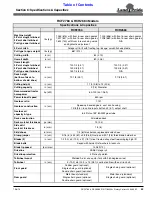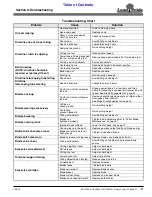
Section 3: Operating Instructions
RCF2784 & RCR2684 S/N Rotary Cutters 326-364M
7/26/19
33
b. Adjust park jack up until cutter weight is off tractor
drawbar.
c. Disconnect hydraulic hose and loop hose back
through spring hose loop for safe keeping.
d. Disconnect driveline from tractor. Collapse
driveline by pushing tractor end of driveline
towards cutter gearbox.
e. Rotate driveline storage hook down and place
driveline in storage hook.
f. Unhook hitch safety chain from tractor.
g. Unhook clevis from tractor and drive tractor
forward several feet.
h. Reinstall bolt, washers, lock washer, and nut in
clevis for safe keeping.
General Operating Instructions
It is important that you familiarize yourself with the
Operator’s Manual, completed Operator’s Checklist,
properly attached cutter to your tractor, made leveling
adjustments, and preset your cutting height before
beginning a running operational safety check on your
Land Pride Rotary Cutter.
The running operational safety check may now be done.
It is important that at any time during this safety check
you detect a malfunction in either the cutter or tractor that
you immediately shut the tractor off, remove its key, and
make necessary repairs and/or adjustments before
continuing on.
Make sure before starting the tractor that the park brake
is engaged, power take-off is disengaged, and cutter is
resting on the ground. Start tractor and set engine throttle
speed at a low idle. Raise cutter with tractor’s rear
hydraulic lift control lever to transport position making
sure that the driveline does not bind and does not contact
the cutter frame. Lower cutter to the ground and at a low
engine speed engage the power take-off. If everything is
running smoothly at a low idle, slowly raise cutter to
cutting height checking for bind or chatter in the driveline.
Lower the cutter to the ground and increase the tractor’s
engine rpm until it reaches the cutter full power take-off
operating speed of 540 rpm. If everything is still running
smoothly, once more raise the cutter to cutting height to
check for driveline bind or chatter. Lower the cutter to the
ground, return engine to a low idle, and disengage power
take-off. Position adjustable stops on the tractor’s
hydraulic lift lever or the Pull-Type hydraulic cylinder rod
so the cutter can be consistently returned to the same
cutting and transport height.
You should now be ready to transport to your cutting site
at a safe ground speed. On roadways transport in such a
manner that faster moving vehicles can easily see you
and pass you safely. Reduce your speed when traveling
over rough and hilly terrain. Avoid quick or sharp steering
corrections. Take extra care to ensure that the mower
doesn’t come into contact with obstacles such as trees,
buildings, or fences. Use accessory lights and
appropriate reflective devices to provide adequate
warning to pedestrians and other vehicle operators when
traveling on public roads and in the dark of night. Comply
with all local, state, and federal laws.
It is important that you inspect the area where you will be
cutting and clear it of safety hazards and foreign objects
either before or after you arrive at the cutting site. Never
assume the area is clear. Cut only in areas you are
familiar with and are free of debris and unseen objects.
Extremely tall grass should be cut twice to detect
potential hazards. In the event you do strike an object
stop the cutter and tractor immediately to inspect and
make necessary repairs to the cutter before resuming
operation. It really pays to inspect a new area and to
develop a safe plan before cutting.
You will need to maintain 540 rpm power take-off speed
and 2 to 5 mph ground speed to produce a clean cut.
Make a tractor gear and range selection that will enable
you to maintain these speed combinations. Generally the
quality of cut is better at lower ground speeds. Dense
ground cover will create the need to slow down even
more. In certain conditions tractor tires will roll grass
down resulting in an uneven cut when the grass fails to
rebound. Should this happen you may try reversing the
direction of cut and/or double cut to achieve the desired
finish. Avoid very low cutting heights especially on
extremely uneven terrain. Always cut downward on
slopes and avoid crossing the face of steep slopes. Avoid
sharp drops and cross diagonally through dips to prevent
hanging up the tractor and cutter. Slow down in turns.
Remember to look back often.
Now that you’re prepared and well briefed you may begin
cutting. Begin by doing the following:
•
Reducing tractor’s engine rpm.
•
Make sure cutter is on the ground in cutting position
and then engage power take-off.
•
Raise engine rpm to the appropriate 540 power take-
off speed and begin cutting.
Make wide turns when possible. 3-Point hitch and
optional Quick Hitch models can be lifted into transport
position to make tight turns and to reverse direction. Try
increasing or decreasing ground speed to determine the
effect on quality of cut. With a little practice you will be
pleased with what your Land Pride Rotary Cutter can do.
Whether you are done mowing, need to take a break, or
just need to make a few adjustments to the cutter,
remember to always do the following:
•
Reduce tractor’s engine rpm and disengage power
take-off.
•
Stop on level ground, set park brake, turn off engine
and remove switch key.
•
Stay on the tractor until the cutter blades have come to
a complete dead stop.
















































